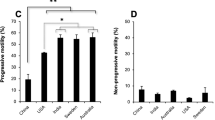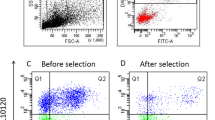Abstract
Purpose
The purpose of this study was to develop a novel one-step ICSI approach to select sperm with better chromatin maturity than the conventional method.
Methods
This was a pilot diagnostic study, which prospectively recruited men during a 6-month period in a University-affiliated infertility centre. Forty consecutive semen samples were provided for analysis. The positive rheotaxis extended drop (PRED) was set up creating a pressure and viscosity gradient. Each semen sample was divided into four aliquots: one aliquot for density gradient centrifugation (DGC), two aliquots for PRED (fresh semen (PRED-FS) and processed semen (PRED-DGC)), and one aliquot as the control (FS). In PRED, a mean of 200 spermatozoa were collected consecutively without selection from the outlet reservoir. The aniline blue assay was used to assess chromatin immaturity.
Results
The mean channel length, measured from inlet to outlet, was 32.55 ± 0.86 mm, with a mean width of 1.04 ± 0.21 mm. In 82.5% of cases (33/40), at least 50 spermatozoa were captured between 15 and 30 min. Improved chromatin maturity after the DGC preparation and the PRED approach was observed in all samples. This was reflected by a mean reduction from 28.65 ± 8.97% uncondensed chromatin in the native ejaculates to 17.29 ± 7.72% in DGC and 0.89 ± 1.31% in the PRED approach (P < 0.01).
Conclusions
The PRED method may improve the current ICSI technique by providing it with its own sperm selection process. ICSI would probably become an even more complete technique comprising selection, capture and injection of the male gamete.







Similar content being viewed by others
References
Fitzpatrick JL, Lupold S. Sexual selection and the evolution of sperm quality. Mol Hum Reprod. 2014;20(12):1180–9. https://doi.org/10.1093/molehr/gau067.
Kantsler V, Dunkel J, Blayney M, Goldstein RE. Rheotaxis facilitates upstream navigation of mammalian sperm cells. elife. 2014;3:e02403. https://doi.org/10.7554/eLife.02403.
Williams M, Hill CJ, Scudamore I, Dunphy B, Cooke ID, Barratt CL. Sperm numbers and distribution within the human fallopian tube around ovulation. Human reproduction (Oxford, England). 1993;8(12):2019–26.
Avendano C, Franchi A, Taylor S, Morshedi M, Bocca S, Oehninger S. Fragmentation of DNA in morphologically normal human spermatozoa. Fertil Steril. 2009;91(4):1077–84. https://doi.org/10.1016/j.fertnstert.2008.01.015.
Sakkas D. Novel technologies for selecting the best sperm for in vitro fertilization and intracytoplasmic sperm injection. Fertil Steril. 2013;99(4):1023–9. https://doi.org/10.1016/j.fertnstert.2012.12.025.
Marchetti F, Wyrobek AJ. DNA repair decline during mouse spermiogenesis results in the accumulation of heritable DNA damage. DNA repair. 2008;7(4):572–81. https://doi.org/10.1016/j.dnarep.2007.12.011.
Yamauchi Y, Riel JM, Ward MA. Paternal DNA damage resulting from various sperm treatments persists after fertilization and is similar before and after DNA replication. J Androl. 2012;33(2):229–38. https://doi.org/10.2164/jandrol.111.013532.
Sakkas D, Alvarez JG. Sperm DNA fragmentation: mechanisms of origin, impact on reproductive outcome, and analysis. Fertil Steril. 2010;93(4):1027–36. https://doi.org/10.1016/j.fertnstert.2009.10.046.
Aitken RJ, Bronson R, Smith TB, De Iuliis GN. The source and significance of DNA damage in human spermatozoa; a commentary on diagnostic strategies and straw man fallacies. Mol Hum Reprod. 2013;19(8):475–85. https://doi.org/10.1093/molehr/gat025.
Derijck A, van der Heijden G, Giele M, Philippens M, de Boer P. DNA double-strand break repair in parental chromatin of mouse zygotes, the first cell cycle as an origin of de novo mutation. Hum Mol Genet. 2008;17(13):1922–37. https://doi.org/10.1093/hmg/ddn090.
Robinson L, Gallos ID, Conner SJ, Rajkhowa M, Miller D, Lewis S, et al. The effect of sperm DNA fragmentation on miscarriage rates: a systematic review and meta-analysis. Human reproduction (Oxford, England). 2012;27(10):2908–17. https://doi.org/10.1093/humrep/des261.
Zini A, Boman JM, Belzile E, Ciampi A. Sperm DNA damage is associated with an increased risk of pregnancy loss after IVF and ICSI: systematic review and meta-analysis. Human reproduction (Oxford, England). 2008;23(12):2663–8. https://doi.org/10.1093/humrep/den321.
Miki K, Clapham DE. Rheotaxis guides mammalian sperm. Current biology : CB. 2013;23(6):443–52. https://doi.org/10.1016/j.cub.2013.02.007.
Amaral A, Lourenco B, Marques M, Ramalho-Santos J. Mitochondria functionality and sperm quality. Reproduction (Cambridge, England). 2013;146(5):R163–74. https://doi.org/10.1530/rep-13-0178.
Cho BS, Schuster TG, Zhu X, Chang D, Smith GD, Takayama S. Passively driven integrated microfluidic system for separation of motile sperm. Anal Chem. 2003;75(7):1671–5.
Schuster TG, Cho B, Keller LM, Takayama S, Smith GD. Isolation of motile spermatozoa from semen samples using microfluidics. Reprod BioMed Online. 2003;7(1):75–81.
Nosrati R, Vollmer M, Eamer L, San Gabriel MC, Zeidan K, Zini A, et al. Rapid selection of sperm with high DNA integrity. Lab Chip. 2014;14(6):1142–50. https://doi.org/10.1039/c3lc51254a.
Asghar W, Velasco V, Kingsley JL, Shoukat MS, Shafiee H, Anchan RM, et al. Selection of functional human sperm with higher DNA integrity and fewer reactive oxygen species. Advanced healthcare materials. 2014;3(10):1671–9. https://doi.org/10.1002/adhm.201400058.
Zhang B, Yin T, Yang J. A novel microfluidic device for selecting human sperm to increase the proportion of morphologically normal, motile sperm with uncompromised DNA integrity. Anal Methods. 2015;7(14):5981–8.
Shirota K, Yotsumoto F, Itoh H, Obama H, Hidaka N, Nakajima K, et al. Separation efficiency of a microfluidic sperm sorter to minimize sperm DNA damage. Fertil Steril. 2016;105(2):315–21.e1. https://doi.org/10.1016/j.fertnstert.2015.10.023.
WHO. WHO laboratory manual for the examination and processing of human semen. 5th ed. Geneva: WHO Press; 2010.
Boitrelle F, Ferfouri F, Petit JM, Segretain D, Tourain C, Bergere M, et al. Large human sperm vacuoles observed in motile spermatozoa under high magnification: nuclear thumbprints linked to failure of chromatin condensation. Human reproduction (Oxford, England). 2011;26(7):1650–8. https://doi.org/10.1093/humrep/der129.
Wong A, Chuan SS, Patton WC, Jacobson JD, Corselli J, Chan PJ. Addition of eosin to the aniline blue assay to enhance detection of immature sperm histones. Fertil Steril. 2008;90(5):1999–2002. https://doi.org/10.1016/j.fertnstert.2007.09.026.
Park YS, Kim MK, Lee SH, Cho JW, Song IO, Seo JT. Efficacy of testicular sperm chromatin condensation assay using aniline blue-eosin staining in the IVF-ET cycle. Clinical and experimental reproductive medicine. 2011;38(3):142–7. https://doi.org/10.5653/cerm.2011.38.3.142.
Fujii Y, Motoyama H, Hiraguchi K, Kobashi C, Kunitomi K. A simple method for recovering the motile spermatozoa from extremely low quality sperm samples. Human reproduction (Oxford, England). 1997;12(6):1218–21.
Hinting A, Lunardhi H. Better sperm selection for intracytoplasmic sperm injection with the side migration technique. Andrologia. 2001;33(6):343–6.
Woolley DM. Motility of spermatozoa at surfaces. Reproduction (Cambridge, England). 2003;126(2):259–70.
Denissenko P, Kantsler V, Smith DJ, Kirkman-Brown J. Human spermatozoa migration in microchannels reveals boundary-following navigation. Proc Natl Acad Sci U S A. 2012;109(21):8007–10. https://doi.org/10.1073/pnas.1202934109.
Seo D, Agca Y, Feng ZC, Critser JK. Development of sorting, aligning, and orienting motile sperm using microfluidic device operated by hydrostatic pressure. Microfluid Nanofluid. 2007;3(5):561–70. https://doi.org/10.1007/s10404-006-0142-3.
Knowlton SM, Sadasivam M, Tasoglu S. Microfluidics for sperm research. Trends Biotechnol. 2015;33(4):221–9. https://doi.org/10.1016/j.tibtech.2015.01.005.
Tung CK, Ardon F, Fiore AG, Suarez SS, Wu M. Cooperative roles of biological flow and surface topography in guiding sperm migration revealed by a microfluidic model. Lab Chip. 2014;14(7):1348–56. https://doi.org/10.1039/c3lc51297e.
El-Sherry TM, Elsayed M, Abdelhafez HK, Abdelgawad M. Characterization of rheotaxis of bull sperm using microfluidics. Integrative biology : quantitative biosciences from nano to macro. 2014;6(12):1111–21. https://doi.org/10.1039/c4ib00196f.
Tasoglu S, Safaee H, Zhang X, Kingsley JL, Catalano PN, Gurkan UA, et al. Exhaustion of racing sperm in nature-mimicking microfluidic channels during sorting. Small (Weinheim an der Bergstrasse, Germany). 2013;9(20):3374–84. https://doi.org/10.1002/smll.201300020.
Avendano C, Franchi A, Duran H, Oehninger S. DNA fragmentation of normal spermatozoa negatively impacts embryo quality and intracytoplasmic sperm injection outcome. Fertil Steril. 2010;94(2):549–57. https://doi.org/10.1016/j.fertnstert.2009.02.050.
Maettner R, Sterzik K, Isachenko V, Strehler E, Rahimi G, Alabart JL, et al. Quality of human spermatozoa: relationship between high-magnification sperm morphology and DNA integrity. Andrologia. 2014;46(5):547–55. https://doi.org/10.1111/and.12114.
Paasch U, Grunewald S, Glander HJ. Sperm selection in assisted reproductive techniques. Society of Reproduction and Fertility supplement. 2007;65:515–25.
Jayaraman V, Upadhya D, Narayan PK, Adiga SK. Sperm processing by swim-up and density gradient is effective in elimination of sperm with DNA damage. J Assist Reprod Genet. 2012;29(6):557–63. https://doi.org/10.1007/s10815-012-9742-x.
Rappa KL, Rodriguez HF, Hakkarainen GC, Anchan RM, Mutter GL, Asghar W. Sperm processing for advanced reproductive technologies: where are we today? Biotechnol Adv. 2016;34(5):578–87. https://doi.org/10.1016/j.biotechadv.2016.01.007.
Aitken RJ, Finnie JM, Muscio L, Whiting S, Connaughton HS, Kuczera L, et al. Potential importance of transition metals in the induction of DNA damage by sperm preparation media. Human reproduction (Oxford, England). 2014;29(10):2136–47. https://doi.org/10.1093/humrep/deu204.
Muratori M, Tarozzi N, Cambi M, Boni L, Iorio AL, Passaro C, et al. Variation of DNA fragmentation levels during density gradient sperm selection for assisted reproduction techniques: a possible new male predictive parameter of pregnancy? Medicine. 2016;95(20):e3624. https://doi.org/10.1097/md.0000000000003624.
Matsuura K, Uozumi T, Furuichi T, Sugimoto I, Kodama M, Funahashi H. A microfluidic device to reduce treatment time of intracytoplasmic sperm injection. Fertil Steril. 2013;99(2):400–7. https://doi.org/10.1016/j.fertnstert.2012.10.022.
Zidi-Jrah I, Hajlaoui A, Mougou-Zerelli S, Kammoun M, Meniaoui I, Sallem A, et al. Relationship between sperm aneuploidy, sperm DNA integrity, chromatin packaging, traditional semen parameters, and recurrent pregnancy loss. Fertil Steril. 2016;105(1):58–64. https://doi.org/10.1016/j.fertnstert.2015.09.041.
Acknowledgements
The authors gratefully acknowledge Henrique P. Fazao and the entire IVF team for their enthusiasm and support.
Authors’ roles
H.M. and M.S.C. played a role in the conception, design and acquisition of the data, drafted the manuscript and reviewed the final version. B.C.T., P.C.S, G.J.A.W and E.P.M participated in data interpretation, critical revision and final approval of the manuscript. P.A.A.M, M.S., J.M.S.J and E.C.B were involved in data analysis, drafting of the manuscript and its final approval.
Funding
This study did not receive any financial support.
Author information
Authors and Affiliations
Corresponding author
Ethics declarations
Conflict of interest
The authors declare that they have no conflict of interest.
Electronic supplementary material
Supplementary Video 1
(WMV 35596 kb)
Supplementary Video 2
(WMV 11713 kb)
Supplementary Video 3
(WMV 2697 kb)
Supplementary Video 4
(WMV 13072 kb)
Rights and permissions
About this article
Cite this article
De Martin, H., Cocuzza, M.S., Tiseo, B.C. et al. Positive rheotaxis extended drop: a one-step procedure to select and recover sperm with mature chromatin for intracytoplasmic sperm injection. J Assist Reprod Genet 34, 1699–1708 (2017). https://doi.org/10.1007/s10815-017-1024-1
Received:
Accepted:
Published:
Issue Date:
DOI: https://doi.org/10.1007/s10815-017-1024-1




